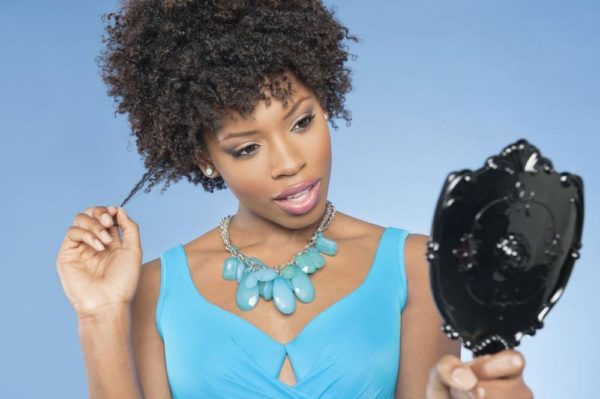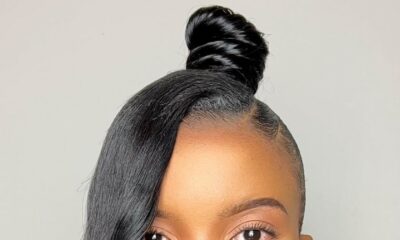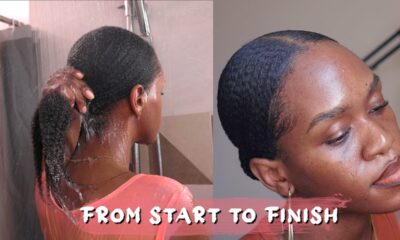Style
Afope: “My Hair is Falling Out…Is it Normal?!” – What You Should Know About Shedding & Breakage

Hair loss is scary for all of us. Aside from the obvious superficial concerns, hair loss has also been linked to certain health problems, and is often an accurate indication of hormonal changes within the body. So it’s completely normal to be somewhat concerned when you begin losing clumps of your hair to your hair brush or better yet your shower drain.
Heck, I’ve been there, and Lord knows I had no sooner rinsed the shampoo out of my hair than I was already halfway to the doctors’ office. It wasn’t till years after that particular incident that I learnt about healthy hair loss.
Yet the question remains; how can we tell the difference between normal hair loss and hair loss we should look into? And how much is too much when it comes to hair loss? Where do we draw the line? In most cases, it’s fairly straightforward; the key is in being able to identify between two forms of hair loss – shedding vs. breakage.
Shedding
Simply put, shed hair is that which has come to the end of its growth cycle and as a result naturally falls out from the scalp including its bulb root. Hair growth cycles usually last up to 6 years and the scalp will shed said hairs in preparation for the next growth cycle. Therefore, as this occurrence is a natural by-product of a healthy and functional scalp, shed hairs cannot be prevented and neither should they normally be a cause for major concern.
Hair growth cycles aside, there are a number of internal changes in the body that have been known to result in increased hair shedding. Many women experience increased shedding as a result of changes that occur during their monthly cycles, menopause and pregnancy – just as women have been known to report increased hair growth during pregnancy so have they commonly experienced postpartum shedding. Finally, increased hair shedding could also be a result of genetic composition, illness, and a sudden change in diet and/or medication.
Breakage
Hair breakage refers to the instances when hair breaks and falls from anywhere other than the root itself and usually occurs as a result of hair malpractice. Such malpractices may include anything from permanent chemical alterations (e.g. colouring, relaxing and other alkaline treatments) to poor handling techniques and dryness. The older the hair is, the more susceptible it will be to such damage. This explains why the majority of us will notice that breakage tends to happen closer to the ends of our hair rather than near the root where the hair is newly grown and had experienced far less natural weathering.
How much is too much?
On average we naturally shed 50-100 strands of hair a day (which is quite a remarkably large number in my opinion) so if you are experiencing more than this you may want to see a specialist about it.
But first, I’d like to clarify something – noticing a lot of hair in your comb/brush or drain after weeks of having a protective style does not necessarily mean what you are experiencing is an increase of shed hair. We’ve all done it, you know, that ‘hold the ball of shed hair hair in my hands and glare at it until it magically reattaches itself to my scalp‘ act we do almost every time we take out twists, braids, or week-long buns.
However, due to the nature of afro-textured hair, our individual hair strands are almost always intertwined with each other, protective styling or not. What this means is that those 75+ strands that would normally fall daily are being intertwined with other hairs until that fateful day when we decide to wash and detangle. Whereas this means we ought not panic as what we see is merely a buildup of shed hairs over a long period of time, it is still key that we make sure we are gentle enough with our hair when trying to separate shed hairs from other hairs in order to avoid creating knots that will cause the other hairs to snap/break.
Testing: Which ones are shed hairs & which ones are broken hair?
The Bulb Test: Place the fallen hair(s) under clear light and if you can spot the tiny white bulb at the root then it is most definitely a shed hair.
The Length Test: Broken hairs are usually much shorter than shed hairs/other hairs on the head as they break from along the strand as opposed to falling from the root. So if it’s noticeably shorter, chances are it’s a broken hair.
The Colour Test: Shed hairs will more than often appear colourless/dull in colour as the hair ceases to produce melanin right before the end of its growth cycle, meaning if the fallen hair appears whiter/duller that other hairs, then it’s more than likely a shed hair.
So there you have it ladies – a brief overview of shedding vs. breakage in order to help us correctly identify and attend more appropriately to our hair needs!
Photo Credit: Photolondon






















